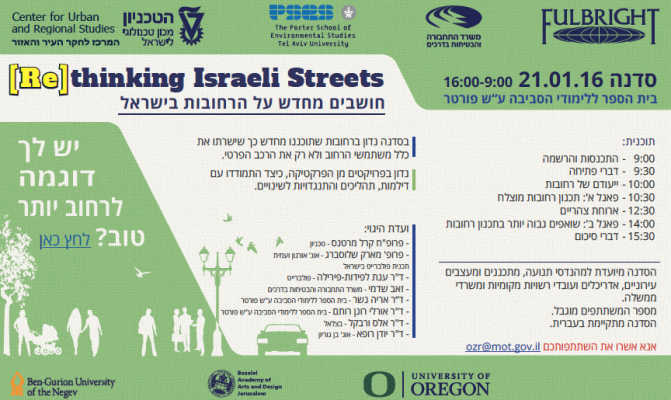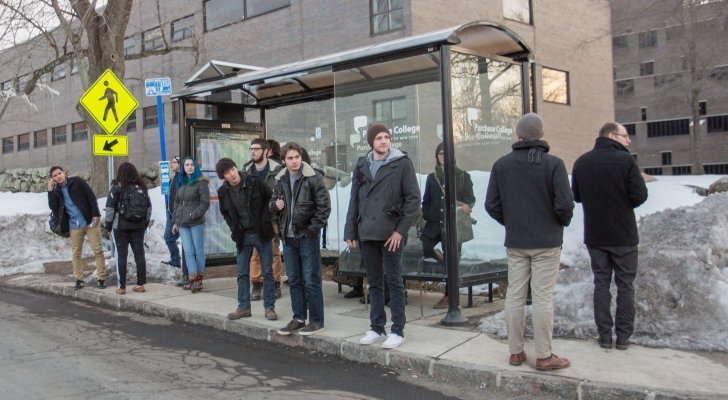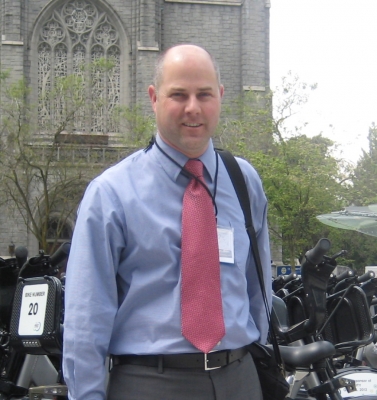NITC researcher Marc Schlossberg is bringing his work on complete streets to a new, international audience: planners and practitioners in Israel.
On Thursday, January 21, a national “Rethinking Israeli Streets” workshop held at Tel Aviv University was attended by around 100 academics and professionals – a significant turnout for this first-of-its-kind event.
Experts gathered at the conference to present their ideas for lessening automobile dependency in Israel’s future, a vision that the Jerusalem Post described as “blissful.”
Schlossberg, who co-organized the conference, is currently working in Haifa under a Fulbright scholarship. As part of his earlier NITC research he co-authored the book Rethinking Streets, an evidence-based design guide for complete street transformations....
Read moreThe National Institute for Transportation and Communities, or NITC, program invites proposals for a new round of research, education, and technology transfer projects for 2016.
NITC is focused on contributing to transportation projects that support innovations in: livability, incorporating safety and environmental sustainability.
This grant is part of the University Transportation Center program, funded by the U.S. Department of Transportation, and is a partnership between Portland State University, the University of Oregon, the Oregon Institute of Technology, the University of Utah and the University of South Florida.
Projects should range from $30,000 to $150,000. Projects can focus on research, education, or technology transfer. All projects submitted for this RFP will undergo peer review. All awards require a 1 to 1.2 (unless otherwise noted) non-federal match in the form of cash or in-kind services from project partners—to include universities, transportation and other public agencies, industry, and nonprofit organizations.
Download the RFP, and visit the researchers page for more details on how to apply.
Abstracts are due March 15, 2016 at 5:00 PM PDT. Full proposals will be due April 15.
The NITC research program has announced its Small Starts grant awards for 2016.
The purpose of the Small Starts grant is to assist researchers who are interested in transportation but have not had an opportunity to undertake a small project—$15,000 in funding or less—that supports NITC's theme of safe, healthy and sustainable transportation choices to foster livable communities.
Projects awarded Small Starts funding in this round include studies of connectivity for active travel routes, explorations of the reasons why people choose active travel modes, and investigations of transportation barriers for the food insecure.
Funded projects in this round are:
- Active and Public Transportation Connectivity between North Temple TOD and Jordan Park River Trail, Ivis Garcia, University of Utah
- Narratives of Marginalized Cyclists: Understanding Obstacles to Utilitarian Cycling Among Women and Minorities in Portland, Oregon, Amy Lubitow, Portland State University
- ...
Today marks the final day of NITC program presentations at TRB. NITC campuses feature in six posters at 8:30 a.m. and one lectern session, at 8 a.m.
Portland State University doctoral student Joe Broach presents a portion of the work that makes up his dissertation at the 8:30 a.m. poster session, in Hall E of the convention center.
Through earlier work, Broach learned the distances cyclists will detour from the shortest path to, say, avoid stop signs or use an off-road path. But that work said little about whether a person was likely to use a bicycle for that trip at all.
That earlier work helped Broach get a sense of actual routes people might bicycle or walk along. For this research, he took that one step further, determining if the features of those routes influenced the decision to walk or bike at all.
The poster is titled, “Using Predicted Bicyclist and Pedestrian Route Choice to Enhance Mode Choice Models” (Paper No. 16-4108).
Broach said he pursued the mode-choice-model approach after the route-choice models alone left some questions unanswered, particularly those of the cycling gender gap. Bike boulevards, the low-traffic neighborhood streets that prioritize cyclists, attracted male and female riders at about the same rates, for example.
But the question wasn’t whether women who had made the choice to bicycle would take bike boulevards. Rather, it was...
Read moreToday is the biggest day of the annual Transportation Research Board meeting for posters and presentations from NITC program affiliated campuses. The day starts with an 8:30 a.m. poster session featuring eight NITC affiliate posters and ends with the NITC reception and transportation trivia.
An "Emerging Research in Bicycling" lectern session at 1:30 p.m. will highlight two separate NITC projects. In one, Portland State University researchers Jennifer Dill and Nathan McNeil discuss their research on the "Four Types of Transit Cyclist" typologies first proposed by Roger Geller of the Portland Bureau of Transportation.
The research follows up on our earlier research, which validated the typologies for the city of Portland. The current project looks at whether it also applies nationwide.
Dill and McNeil asked a sample of 3,000 people in the 50 largest metropolitan areas in the U.S. to state their comfort bicycling in various environments, their interest in bicycling and recent behavior. They found that the distribution of people who can be categorized in the four groups:...
Read moreMonday is the first day for lectern and poster sessions at TRB. Researchers from universities affiliated with the National Institute for Transportation and Communities program have 12 presentations on the day's schedule.
Chris Monsere of Portland State University presents "Operational Guidance for Bicycle-Specific Traffic Signals in the United States" at an 8:30 a.m. poster session in Hall E (all listed rooms are in the Walter E. Washington Convention Center). The poster is part of a state department of transportation high-value research session.
Last July, the project, led by Monsere with co-investigator Miguel Figliozzi, was honored as a "Sweet Sixteen" project by the Research Advisory Committee to the AASHTO Standing Committee on Research. Each year, the committee collects High Value Research highlights from member states across the country. From these, each of the four RAC regions selects its top four projects to form the Sweet Sixteen.
More information on the research is on the project page.
Other highlights for the day
- Nicholas Stoll of Portland State University gives a lectern presentation on using bus GPS data to identify congestion hot spots at 8 a.m. in Room 150A. Read our feature story on this research.
- Patrick...
Sunday, the first day of the Transportation Research Board annual meeting in Washington, D.C., is workshop day. Portland State University doctoral student Tara Goddard presents in a showcase of research stemming from the prestigious Dwight D. Eisenhower Transportation Fellowship program.
Goddard probed the question of why so many bicyclists die in traffic crashes. Cyclists are 12 times more likely to be killed in a crash than a driver or passenger in a car. She wondered what role drivers' attitudes toward cyclists might play.
Goddard's research uses a survey to measure drivers' attitudes and self-reported behaviors and to test drivers' implicit attitudes toward both other drivers and cyclists. She pairs the survey piece with a lab experiment that uses hazard-perception video clips to examine whether drivers notice cyclists.
By this approach, Goddard hopes to understand drivers' attitudes and whether those attitudes can predict how they act on the road. That understanding can potentially lead to steps to improve cyclist safety. Her workshop runs 9 a.m. to noon in Room 202B of the Walter E. Washington Convention Center.
Disaster recovery workshop
John MacArthur of TREC presents "Smart, Shared and Social: Enhancing All-Hazards Recovery Plans With Demand...
Read moreLast month, the U.S. Department of Transportation released an ambitious plan to make sure the public has access to federally funded research. The plan could have far-reaching effects both inside the department and with organizations such as states, universities and contractors.
To help the transportation community sort out implications of the plan, two Transportation Research Board standing committees—Library and Information Science for Transportation and Conduct of Research—are sponsoring a workshop Sunday during the TRB annual meeting. The workshop, from 1:30 to 4:30 p.m., will offer background, plan details and training on the new requirements along with best-practice case studies.
Although the plan includes many exceptions, it represents a big step toward the goal of making publicly funded research available to the public, said Kendra Levine, co-chair of the LIST committee and research librarian at the University of California Berkeley’s Institute of Transportation Studies Library.
In the past, it hasn’t always been clear...
Read morePainted as the “next big thing” in transit, bus rapid transit systems have the luster of a new concept -- and the lack of research literature to match. A NITC research project set out to change that, producing a far-ranging research report delving into the influence of BRT on jobs, housing and development.
Bus Rapid Transit systems occupy a space between regular bus and light rail systems. Like regular bus systems, BRT systems typically use rubber tires and internal combustion engines and run on paved roads. However, the systems may share many features with light-rail trains, including exclusive lanes, off-vehicle payment systems and low floors and large doors for quicker boarding.
Led by Arthur C. Nelson at the University of Utah’s Metropolitan Research Center, the project, “National Study of BRT Development Outcomes,” looked at systems around the country, finding evidence that BRT systems influence development patterns in important ways. The research found that BRT systems are tied to positive outcomes for development and job location, although not necessarily changes in population or housing.
Bus rapid transit systems hold the promise of bringing communities some of the positive outcomes traditionally associated with light-rail transit systems but at a lower cost. The research will be of interest to...
In recent decades, Bus Rapid Transit (BRT) has gained popularity across the United States due to its relatively low costs of development (compared to the investment requirements of putting in a new light rail system, for example) and its potential to drive economic development.
However, there is a need for more comprehensive research devoted to understanding its economic impacts across various sectors.
NITC researcher Joanna Ganning is the lead author on a research paper that will be presented at the annual meeting of the Transportation Research Board this month, which seeks to estimate the effects of BRT stations on employment growth.
Using Longitudinal Employer-Household Dynamics data, Ganning and her research team investigated the impacts of BRT on employment changes of each major industry sector between 2002 and 2010.
The researchers analyzed employment data surrounding 226 BRT stations along nine BRT corridors which were opened during the study period, as well as employment data from equally sized areas around control points.
Metropolitan areas included in the analysis were Phoenix, Los Angeles, Kansas City, Las Vegas, Salt Lake City, New York City, Cleveland, Ohio and Eugene, Oregon.
With the presence or absence of BRT stations as the independent variable, the team found that BRT statistically significantly influenced employment change for just one...
Read more








